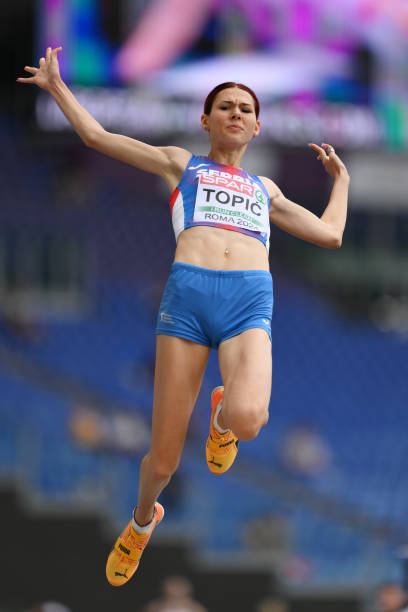This year World Athletics introduced the three distinct categories for the athlete of the year title, track, field and road (they called it "out of stadium" so as to be able to include cross country) right from the outset (last year they surprised everybody by naming winners in the three categories at the last moment). The finalists list has appeared and there are 2+2 athletes from each group selected.
Here is the list (I present them in the order track-field-road) for women
Julien Alfred
Sydney McLaughlin-Levrone
Yaroslava Mahuchikh
Nafissatou Thiam
Ruth Chepngetich
Sifan Hassan
and men
Jakob Ingebrigtsen
Letsile Tebogo
Mondo Duplantis
Miltiadis Tentoglou
Brian Pintado
Tamirat Tola
(Just in case you, like myself, had to ask the question "who is Pintado" the answer is that he is an ecuadorian race-walker who won the Olympic title over 20 km).
Seeing the list one is tempted to make predictions. The case of men's choice is rather easy. I don't think that Pintado and Tola have a real chance. Ingebrigtsen had a good year but the fact that he was defeated over the 1500 and the mile diminishes his chances. Tebogo would have been the undisputable favourite if he had won the 100 m or, at least, if he had led Botswana to victory in the 4x400 m relay. This leaves us Duplantis and Tentoglou. Duplantis was athlete of the year 2022 and was crowned European athlete for 2024. So, I cross my fingers for Tentoglou (and, as you can imagine, I voted for him once the fans' votes were open). But if Duplantis gets the title I will find this perfectly natural.
In the case of women I am much less at ease with predictions. I don't think that either Chepngetich or Hassan can win the title. And Alfred's defeat in the 200 m may prove enough to remove her from the serious contenders. Mahuchikh just won the European title for the athlete of 2024 and this should diminish her chances for the world crown. (But given that lord Sebastian is a great supporter of Ukraine, one cannot be sure). This would leave Thiam and McLaughlin. Thiam secured a third olympic heptathlon title while McLaughlin won the 400 m hurdles title with a great world record. The latter was athlete of the year in 2022, so perhaps this time Thiam will be the one to be crowned. As my regular readers know, I am a great admirer of McLaughlin but this time I voted for Thiam. Of course, it would be perfectly OK if McLaughlin got the title for a second time.
World Athletics published the list of finalists for the Rising Star title. Here they are
Mattia Furlani
Jaydon Hibbert
Niels Laros
Sembo Almayew
Angelina Topic
Ziyi Yan
Furlani is second in my list of rising stars but since I had placed Wanyonyi (who joined the list of "grown ups" for World Athletics) in first place it is as if Furlani were first. He is my favourite for the title. Laros has just obtained the European title (and so his chances are minimal). As for Hibbert, who figured in my last year's list, I feel that he did not live up to expectations.
I had simply overlooked Almayew for my list and I only recently came to know about Yan. (By the way, World Athletics refers to her in the finalists list as Yan Ziyi, which is the chinese way to give the surname before the name. In fact, in the athlete's profile they are indicating Yan as her surname. However, as for all the other finalists the western-style convention name-surname is used, one is misled into thinking that Ziyi is her surname. One would have hoped that an organisation like WA would have some consistency. But, alas, Lord Sebastian is otherwise occupied). Yan is a superb javelin thrower, very fast and strong, but I don't think that she can grab the title. (If Vilagos and Tzengko manage to realise fully their potential and Yan matures into a top thrower, my fears about female javelin throw, could turn out to be unjustified). The favourite, to my eyes, is Topic. She was my last year's choice and although I decided to put Manuel at first position this year I pointed out that Topic is always my preferred athlete.
I had finished the article and I was ready to publish it when, all of a sudden, I realised that I was not thinking clearly: already last year World Athletics had nominated three "year's best" athletes, one per speciality. So my striving for a prediction of the absolute year's best was unnecessary. With three "best" my prediction for women is easy: McLaughlin, Thiam and Hassan. The situation for men is more complicated. I would select Tebogo over Ingebrigtsen, Tentoglou over Duplantis and Tola over Pintado but I may be 33 % or 67 % or even 100 % wrong. In fact this year WA may go for a race-walker (there has never been one nominated athlete of the year), confirm once more the supremacy of Duplantis (I guess that last year's split into three categories was introduced in order to avoid the Duplantis-Lyles dilemma) and reward Ingebrigtsen, who has been, somehow overlooked the previous years. We'll know in December.
Finally, judging from what happened last year, we may not have access to the finalists for the photograph of the year contest and will have to content ourselves with just the winner.
PS It turned out I was wrong concerning the finalists for the photograph of the year. Three photos were posted on the WA website and there was a promise that all 11 shortlisted ones will appear later this month. Given that there is only one photo worth mentioning among the finalists (the one with Hassan and Assefa) and that I am afraid that WA will select the photo of Lyles, I am not publishing my choice here but keep it for the article where I will comment on the winners.












